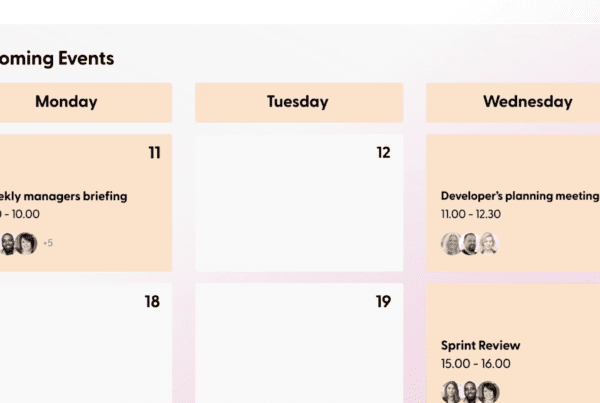We’ve all felt it. That flutter of emotions before we start a new role.
Anticipation. Excitement. Uncertainty. Even anxiety.
What will our new role bring?
How will we fit into the existing team? Will we be able to perform the contractual duties with finesse?
These feelings are universal. It doesn’t matter where you are on the career ladder. Whether it’s your first step on the career ladder or promotion to a senior decision-maker position, starting a new role presents a new and unique set of psychological and aptitude challenges.
The first few weeks are crucial. For any new starter and the existing team infrastructure. And this is something that organisations often don’t account significantly enough for. Why? Well, in the first few weeks, new starters absorb organisational values, learn their routines, understand the demands of their new role, and so much more. It’s when the foundations to prosper are laid. 🚀
But, what of the organisations?
Well, the organisation is responsible for providing the right infrastructure to support their employees. Both seasoned and new.
It’s more than just providing a laptop and a handful of platform login details. Introducing new starters to their colleagues. Outlining the daily routine and responsibilities.
It’s everything, it covers the whole workplace experience and it starts with effective induction training.
The bottom line is that developing strong, helpful, informative, and engaging induction training is paramount. Without it, you might just find you have people – even teams – with significant skills, and little idea how to apply them! 😕
Let’s take a deeper look at the definitions and benefits of induction training, including why it’s important that your organisation employ online platforms throughout the induction process.
What exactly is induction training?
Sometimes defined as onboarding or orientation, induction training is a process that introduces new employees to their role and workplace environment.
There is no “one size fits all” approach to cross-sector induction training. It’s often tailored to the organisation and responsibilities of the role. However, an effective induction training programme will help new starters get acclimated to their new role, and the organisation as a whole, quicker.
Imagine you’ve just started a new role. You don’t know anyone. You don’t yet have full access to the IT infrastructure. You don’t even know where to make a brew! Induction training answers all these questions and more. ☺️
Induction training can last a week, or in some cases even a month or longer to complete.
It depends on the organisation and the role. You can expect to receive an introduction to the organisation’s mission, goals, and values. How you fit into the organisation. Relevant policies and procedures. And more.
The purpose of induction training is to help new starters understand their role and the organisation so that they can hit the ground running.
The importance of induction training cannot be overstated.
Not only does it encourage new starters to perform well from the get-go, but it also leads to sustained high productivity levels throughout the course of employment. 👍
What are the four main types of induction training?
Induction training can be split into four main categories. When used effectively, organisations build a solid foundation for new employees to take off and become valuable assets.
Remember, organisations have invested much time and effort into finding the right person. Making them feel valued, increase their level of engagement, and encourage them to excel. But recruitment is just the beginning. Now it’s time to create an infrastructure that allows new starters to become stellar advocates of your organisation.
We’ve outlined the four main types of induction training below.👇👇👇
Number one: formal induction programmes
Formal induction programmes typically include orientation sessions, presentations, and training modules, each covering organisation policies, values, culture, history, and structure. Additionally, they should also include sessions on compliance, workplace health and safety, and any other relevant policies and procedures.
Number two: informal or social induction
This part of the induction training focuses on the social aspects of integration to help new starters feel comfortable and connected from their earliest moments working at the organisation. Informal induction can involve activities, including teambuilding exercises, mentorships, social events, and networking opportunities. 🥳⚽🤝
The goal of informal or social induction is to facilitate employee relationship building. Both for new and seasoned employees. This promotes a sense of understanding, appreciation, and camaraderie whilst simultaneously promoting a sense of security, belonging, and engagement.
Number three: on-the-job training (OTJ)
Theoretical learning may be a sound way to acquire knowledge, however there is no substitute for “doing” something. It is, for many people, the best way to learn to perform a task. Therefore, induction training often involves on-the-job training (OTJ). 🖥️
By applying what they’ve learned in a real-world context, employees gain valuable direct, practical experience. Of course, direct training is more valuable to some careers than others.
For instance, electricians first learn how to install electrical equipment in a house or premises. Then they go on-site. Through experience, they learn to be adaptable and technically proficient in a range of different circumstances.
OTJ training is valuable or even essential to an induction. Through coaching or mentoring, new employees can better adapt to the rigours and responsibilities of their new role and the environment. 👏
Number four: e-learning or online induction
It’s the digital age, Generation Z, even millennials’ lives are more integrated with technology than any other generations before them. Very few roles don’t require a strong technical focus. This means that for organisations to create a learning environment that yields actual learning, they need to leverage e-learning.📱
The heart of your workforce aside, e-learning through online platforms, can make, often dense, dry, topics, like compliance policies and company procedures easy to digest and retain information.
Better still, when combined with OTJ training, online inductions promote flexible training. They give new employees the opportunity to access vital information at a time and pace to suit them, whilst promoting strong learning practices, like assessments, to ensure understanding.
Main benefits of great induction training
Effective induction training programmes can benefit both individuals and employers in several, vital ways. Informative, engaging, and inspiring induction training programmes can, indeed, make the difference between individuals and employers experiencing an immediate alignment in expectations, values, and benefits to forming a working partnership and not.
Let’s review the benefits induction training has on new employees and organisations in a little detail below. 👇👇👇
Organisational benefits
- Reduction of employee turnover rates: any new starter who has access to the right resources, i.e., people, online platforms, and any additional resources to learn the new role whilst being embraced by welcoming people, they’re more likely to become proficient in their roles quicker and reduce employee turnover rates.
- Enhanced operational efficiency: strong induction training helps new starters build strong foundations to enjoy continual success. They’ll quickly be able to understand the organisation, their role, day-to-day tasks, and performance goals. This will result in enhanced operational efficiency across the whole organisation.
- Make the employee feel valued: a welcoming environment, one that provides the new starter with everything they need to succeed, will make the employee feel valued. This will ease any transition period and reinforce initial happiness, encouraging strong initial new starter performance.
- Optimise technology learning curves: there’s traditionally a technological learning curve when new starters join an organisation. From online platforms to tailored software, optimising learning curves through a dedicated induction training period will help new starters to become technologically fluent in all relevant IT systems quicker, improving productivity and helping organisations achieve seamless onboarding.
- Opens communication lines: a strong induction training programme immediately opens communication lines between organisations and new starters. This helps new starters to feel confident asking questions relevant to helping them to feel comfortable as they begin their new role.
New starter benefits
- Familiarisation with an organisation’s culture: the quicker a new starter can familiarise themselves with an organisation’s culture, the easier their transition will be. This means adapting to the organisation’s mission, values, people, even policies and history will benefit new starters. And induction training can provide just that.
- Meeting new colleagues and their roles in the organisation: induction training gives new starters the chance to meet with whom they’ll be working. This allows them to build relationships, fostering communication and collaboration and eases the transition when starting a new role.
- Learning essential knowledge and skills: when starting a new role, new starters will need to learn essential knowledge and skills to perform their roles with finesse. This includes everything from product or service training to health and safety procedures.
- Resources and additional support: ongoing support and resources can be essential to helping people to perform to their full potential. This will allow them to build confidence, reduce stress, and feel like a valued member of the organisation quicker.
- Access to further learning and development opportunities: organisations that excel at providing superior induction training tend to experience new starters remaining loyal to their organisation for twice as long as those that don’t.
Effective induction training is paramount. It’s the most important part of an organisation’s onboarding. It creates an organisational framework for success, whilst setting the right tone for all new hires. 🙌
Remember that strong appointments aren’t solely determined by the decision-making at the hiring stage. They’re built from the earliest days that a new hire joins the company through to the four phases of successful onboarding. Induction training plays a significant role in this success.
Key things to cover in the induction process
Now, we’ve already alluded to some of the core components of a successful induction process. But the bottom line is that new hires should feel welcomed and supported whilst benefiting from an existing infrastructure.
Do this and your organisation will foster new starter success from the get-go, success that’ll continue throughout the during of the new starter’s employment? The result? Employee happiness and loyalty. 😄
So, what should be covered throughout the organisation process? Below are the essential aspects employers should cover in the induction process.
- The history of the organisation (from foundation to time of induction)
- Outline the organisation’s culture, vision, mission, values, policies and procedures (what the organisation stands for, dress codes, working hours etc.)
- An overview of the new starters’ role, responsibilities, expectation levels etc.
- Introduction to the company structure
- Organisational objectives, including attained goals and future objectives
- Industry and role-specific training, including the products or services, systems and processes, and health and safety
- Potential training and development opportunities
- DEI awareness and policies
- The social side of the organisation (both online and offline events)
This may seem like a lot of things to cover. However, do so and you’ll cement the organisation’s brand ethos in the minds of new starters whilst increasing their general understanding of their responsibilities and opportunities.
Leverage learning platforms to support strong induction training
In the end, building a robust induction training strategy is one of the easiest and best ways to bolster your L&D – and, as one of the most trusted LXP platforms, Thirst can help you both streamline and strengthen your induction training.
What does this mean? New starters capable of hitting the ground running, adding value to an organisation from the earliest point in their career and excel as their role is scaled, whilst simultaneously fostering long-term loyalty that will improve organisational performance now and in the future.
Want to learn more about Thirst’s innovative, industry-leading platform and how we’re shaping learner engagement? Get in touch and book a demo today. 👍
For more e-learning insights, resources and information, discover the Thirst blog.
You may also enjoy:
How to Build a Learning and Development Strategy in 2024 | The Ultimate Guide to Sharing Best Practices | What Is Learning Transfer? The Complete Guide






